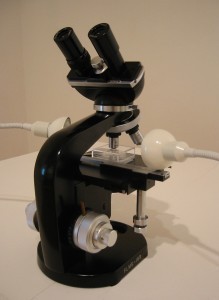Size of Microscope
Microscope sizes are diverse. Some models on the web measure 3.5 x 3.5 x 8.5 inches. Other variants sold are bigger at 4.5 x 4.5 x 10.5 inches. Still others are much larger at 4.5 x 5.5 x 12.0 inches.
Overview
As the means for magnifying objects, the device has become a mainstay in classrooms, scientific and medical laboratories. There are many types, and these are classified by the kind of image being produced.
Some are classified by their degree of automation, illumination method or field of view. Other types differ by the depth of field, magnification and resolution. Most of the time however, these tools are classified as compound, confocal and electron.
Electron Microscopes
These are among the most advanced types currently available. Electron microscope sizes differ, but they are used extensively in geology, medicine and archaeology. These are utilized for examining organs rock layers and other objects. These devices point electrons at the object being examined.
The way the electrons scatter is assessed. Transmission electron microscopes provide one with a 2D view of the material. In contrast, the scanning variety gives a 3D appearance of the object. The images shown however, are in black and white. But they are clear enough to see the peak and valleys of fossils.
Confocal Microscopes
This employs a laser beam to light up the object. The image is enhanced to the point it can be examined easily on a monitor. The object to be examined is often dyed so greater contrast is produced. The object is set on a glass slide for examination. These have motorized mirrors and are controlled automatically.
Compound Microscopes
These are the most basic types. These are the ones used in classrooms. These are manually operated. Light bulbs or ambient light is used to highlight the specimen. The object to be tested is placed below the lens.
A dial is utilized to focus on the object. Magnifying lenses and mirrors are also used. These types are frequently utilized in biology. Depending on the model, it may be sufficient to see eukaryotic cells. Hair strands are also visible.
In terms of resolution, these cannot compare with the electron types. But for most school projects, they will be sufficient.
The different microscope sizes and their magnification have their own purposes. Before you get one, make sure to examine your needs. There are several types to choose from, so there are plenty of alternatives.





